Legendary M.V. Vodop'yanov
Among the outstanding domestic pilots there are names that have become truly legendary. One of them is Mikhail Vasilyevich Vodopyanov. Flying over complex arctic air routes, including directly to the North Pole, opening long-haul flights, combat work in the sky of war, including participation in one of the first bomb raids on Berlin in 1941, today these famous pages cannot be imagined. stories our aviation without Vodopyanov.
Glory came to him in the days of the rescue of the Chelyuskinites, who were in distress in the Arctic waters. 16 April 1934 in the USSR was introduced the title of "Hero of the Soviet Union." Four days later, seven pilots who evacuated the ship’s crew to the mainland were awarded it first. Hero of the Soviet Union number 6 became the pilot of civil aviation M. V. Vodopyanov.
“Vodopyanov had to fly more than five thousand kilometers in order to take part in the rescue of the Chelyuskin crew,” the Red Star wrote at the time. “But this is not so much for the one in whose track record of three hundred twenty thousand kilometers of the air route ... In 1929, in the column“ Types of Machines ”, Vodopyanov was allowed to fly only on the Konek-Gorbunok aircraft. Then “Fokker C-IV”, “Junkers U-13” appeared ... Now he has more than two thousand flying hours and only in 1930 a year, he made one hundred twenty-five thousand kilometers ”.
In the air Vodopyanov came for the love of technology. He was born in a peasant family in the village of Studenki, near Lipetsk. From childhood, he had to help his father, and he learned how to mow, plow, thresh, and saw boards. Dreamed of becoming a shepherd. Only a year went to school, then again I had to go for a plow. I first heard about the airplane from the son of a neighbor-shopkeeper. They were shown in the "foggy pictures" of cinema. But the first real shock was for him to meet with a "live" car in Lipetsk. Struck by Michael "was ready to run after him without end." When I saw the first airplane flying over the village, “I almost fell off the roof,” which they used to fly with their father. How could such a large object fly? This question did not give him rest.
And it was about the heavy multi-engined airplane “Ilya of Murom”. The air force with these aircraft was then based near Lipetsk. And when Vodopyanov volunteered for the Red Army in 1918, he manages to get into this part. He started from the position of coachman - he brought gasoline to the aircraft on a horse, then he moved to the driver’s cabin and, finally, he helped the aircraft mechanic. At the same time studying faults in the engines and other parts of the aircraft. For diligence and skill in repairing aircraft he was taken on a flight as a passenger. Therefore, after demobilization, he no longer thinks himself without technology and travels to Moscow.
For nearly half a year, she strikes the Dobrolet doorsteps, earning money by unloading wagons. And, finally, it is drawn up by a mechanic in the brigade of F.I. Groshev, flying to the North with the pilot Babushkin. Soon he was already a flight mechanic at the famous pilot I. V. Mikheev and was flying with him in Dagestan, spraying the fields. Having independently repaired the Avro training aircraft, Vodopyanov has been trained in flight business for three months, and in 1928, he is already a pilot of civil aviation. With a six-month experience, as an experienced pilot, he is sent to open a new line Khabarovsk - Sakhalin. And he opens it in January 1930, being at the same time a pilot and “attendants” clearing the runways.
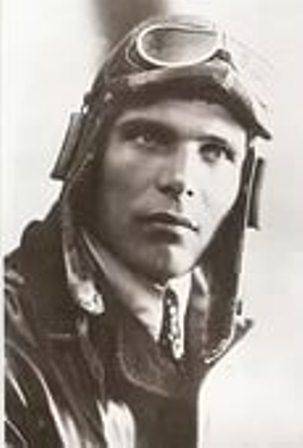
On horses and dogs this way was overcome in thirty days. Each person sent to Sakhalin was then given two thousand daily allowances - one for uniforms and one for food and travel. The ticket for the plane cost only 350 rubles for five to six hours of flight, so the poor traveler could not even receive daily subsistence allowance for that day.
In May 1930, the year Vodopyanov makes its first long-distance flight Moscow - Khabarovsk for forty-one flying hours. After that, he receives an order to retrain to a sea pilot. Training took place over the Amur, and was to fly over the sea. Recalling his first flight over the sea surface, he said that he had to turn to passengers with the question - are these large waves or not? Those hesitated, and how surprised he was when it turned out that it was only a swell. In the same year, Vodopyanov participated in a reconnaissance expedition to determine the number of beluga whales and seals in the Sea of Okhotsk, where they had not been harvested before. All the Shantar Islands were flown around, sometimes the raid was almost nine hours a day.
In 1931, when organizing a Pravda detachment, which was supposed to ensure the delivery of newspaper matrices to major cities in the country, Vodopyanova was also appointed to it, although he had no experience of night flights. And again I had to learn "on the go." The first night flight to Leningrad. “It's simple,” advised the squad leader. “Put up a 320 ° compass course, take the railroad and go straight along it to Leningrad.” But in the end, due to the loss of the course, a delay of three hours. But Vodopyanov made his last flight to this city in two hours and forty minutes instead of the usual three.
In February, 1932, he was involved in the exploration of seals in the Caspian Sea, taking off once on skis from a narrow strip of snow brought from the field. In gratitude received from the animal-breeding trust, the pilot read that the plan was fulfilled thanks to “an amazing ability to navigate in the air with thick fogs so typical in the Caspian Sea and its considerable self-control and experience”. Then work on the passenger line Moscow - Sverdlovsk, in the transaviation of the distillation of winged cars in the Far East and Central Asia, including the first aircraft with a frame made of stainless steel - "Steel-2".
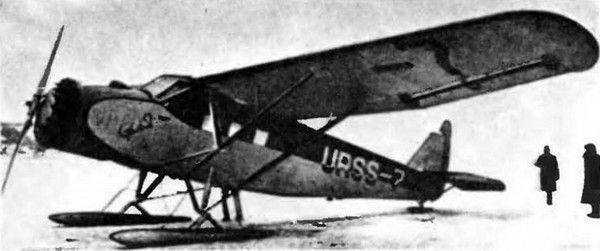
In September, 1932, the year Vodopyanov makes an experimental flight - the distillation of the aircraft P-5 with the air cooling system modified by flight engineer Matveenko to facilitate operation in winter conditions. The aircraft was transferred to Khabarovsk at a record speed in three days. The magazine "Civil Aviation" noted then that "the flight is a clear proof of the excellent qualities of the aircraft and the engine of Soviet production, the rare endurance and experience of pilots ..."
Amazing was the fate of the aircraft P-5. To speed up the testing of the P-5 reconnaissance aircraft, four specimens were built. However, the test flights of the first prototype were so successful that the rest were out of work. Then Polikarpov offered the second aircraft, equipped with the Soviet engine "M-17", to transfer to the May Day 1930 of the GVF. The perfection of the P-5 design was confirmed by his victory in the fall of 1930 at the International Competition in Tehran. And it so happened that the second copy of the P-5 went to the young pilot M.V. Vodopyanova. With a civilian number, he began to transport mail and the Pravda matrix. Then Vodopyanov converted it to a limousine, increasing the speed to 10-15 km / h, set the heater, and heated it under his feet, so that it was possible to fly at a forty-degree frost.
However, 13 February 1933, the plane crashed in the vicinity of Lake Baikal when flying to Kamchatka. The lack of training in the organization of the flight and the overwork of the pilot had an effect. As a result, the death of on-board mechanic Seregin, serious injuries to the pilot and damage to the aircraft. However, at the insistence of Vodopyanova, he was restored, converted into a limousine for five people with a trunk. Installed spare gas tanks, thermometer and upper water tank, so as not to freeze the drainage pipes. Put the muffler with the heating of the cockpit. However, with the conversion of the case at the factory was slowed down. Sometimes, the pilot leaves the factory, and the plane rolls out of the hangar. The Komsomol organization then rescued, and after-hours the young workers completed all the work. And in February 1934-th repaired car was ready for long-haul flights.
And on February 13, in 155 miles from Cape North, crushed by ice, the Chelyuskin sank. 104 people were on the ice. 57 days she will be their haven. And the pilot Vodopyanov, expressing readiness to fly to the aid of the victims, writes a statement to the editorial board of the newspaper Pravda. He assures that his P-5 is fully suitable for any flights at any time of the year and under any atmospheric conditions, as well as in the Arctic environment. "
To shorten the path to the Chelyuskin ice floe, Vodopianov flies through the Anadyr Range, where several crews died. This flight is the head of the Polar Aviation Department M.I. Shevelev called "outstanding." In his car for three flights, Vodopyanov brought ten people. According to reviews of the foreign press, Soviet pilots performed "one of the most dramatic rescue operations in the history of the Arctic."
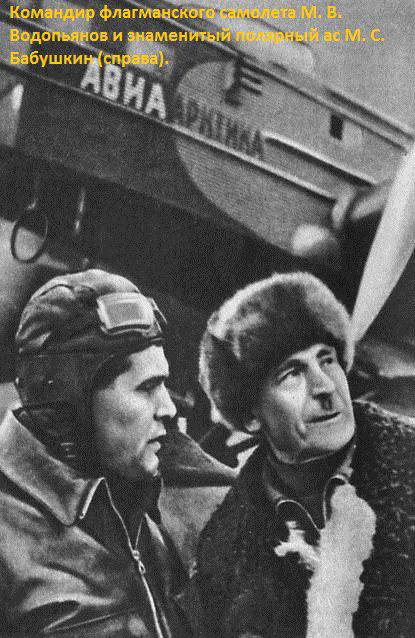
After Vodopyanov had to "face the white Arctic silence, his unique and deceptive beauty, which lies in deception at every step," he has since and forever loved the harsh land. After rescuing the Chelyuskinites, Vodopyanov becomes a polar pilot.
Considering him to be one of the most energetic supporters of the development of flights deep into the Arctic, polar explorer O. Yu. Schmidt turned to Vodopyanov with a question - is he ready to undertake the development of a project for a trip to the pole in order to deliver the polar station and wintering camps there. And Vodopyanov agreed. The pilot's answer was the manuscript of the book “The Pilot's Dream”, which Vodopyanov showed at the Main Directorate of the Northern Sea Route O. Yu. Schmidt. In the book, and then in the play, he seemed to reflect on his dream of flying to the pole, which cost the lives of more than one Arctic explorer.
In 1936, for the exploration in the Arctic Ocean, the crews of M.V. Vodopyanova and V. M. Makhotkina perform the flight Moscow - Franz Josef Land. A year later, the pole was conquered.
21 May 1937, the aircraft "USSR H-170" ("ANT-6") under the command of M.V. Vodopyanova performed the first landing in the world on the "edge of the globe," delivering the "four Papanins." Subsequently, already in the post-war years, Vodopyanov will take part in the organization of ice stations SP-2, SP-3, SP-4. Foreign newspapers wrote: "Truly, now is the time of technology and miracles." The commander of the US Army Aviation Corps, General Westover, in his greeting to Vodopyanov and his crew, noted that "this flight will greatly assist in reducing the world's air routes." And this was confirmed by the flights of V. Chkalov and M. Gromov made in the summer of the same year across the North Pole to America, which became possible thanks to the flights of the winged intelligence officer Vodopyanov.
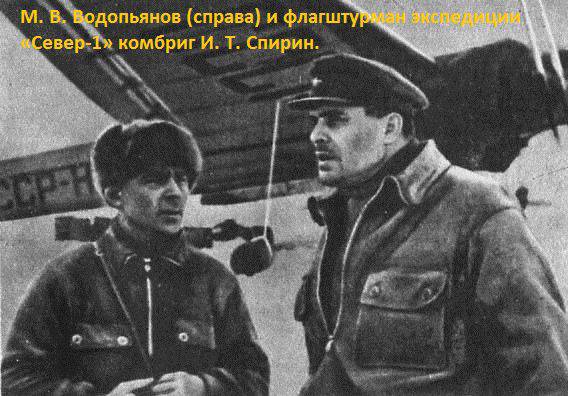
21 June 1941, the crew of Vodopyanova conducted ice reconnaissance over the Kara Sea. 25-hour flight came to an end when the radio operator Bogdanov announced the beginning of the war. After returning to their base, the crew heard from the commander: “I will go to the front” and also supported him. A list of volunteers from 22 people who were all "under reservation" was compiled. Arriving in Moscow, Vodopyanov received on him Stalin's visa - "I agree."
Vodop'yanov, even before the start of the war, addressed a letter to Stalin about the expediency of organizing a special bomber formation equipped with heavy four-motor TB-7. A little earlier, with a similar proposal to the Supreme, Golovanov was leaving. Thus, the idea of a special unit literally soared in the air. With the beginning of the war, Stalin decided to implement it. 29 June 1941 began the formation of the 81 division under the command of Vodopyanova. The division included 412 TBAP on TB-7 and 420 TBAP on Ep-2. These cars were able to "get" to Berlin.
Soon the order was received: "... t. Vodopyanova ... from 9 in August or one of the following days, depending on the weather conditions, to make a raid on Berlin ... to count as a backup target for the bombing of Koenigsberg. Stalin. "
Only two weeks were allotted for the preparation of the operation. In such a short time, of course, it was extremely difficult to bring high quality aircraft. Not enough time and the necessary training of the crews. Of course, the experience of polar pilots and civilian pilots was not to occupy, they were accustomed to fly in difficult times at night, but military skills were completely absent - knowledge of tactics. Features aiming, bombing and anti-aircraft maneuvers, and standard for civilian navigators laying a course on such notable landmarks as cities - could cause death over enemy territory. The raid on Berlin was the first combat mission of the air unit, the formation of which was completed only on July 29. They decided to take off from the airfield of Pushkin, which was located near Leningrad. The length of the entire route was 2700 km, which was 500 km less at the start from Moscow airfields. In addition, the main part of the route passed over the Baltic, bypassing the areas protected by air defense. Only 500 km remained to fly directly over the territory of Germany. Unfortunately, the rush to prepare a negative impact on the results of the raid. Failures were pursued by pilots from the very start. One bomber on take-off refused two engines, he fell near the airfield and exploded. The second plane was mistakenly shot down by its own anti-aircraft gunners over the Gulf of Finland. Two more bombers, due to engine malfunctions, bomb the reserve target and return. After midnight, the remaining six out of ten cars still reach the enemy capital. 10 tons of deadly cargo crashes into Berlin.
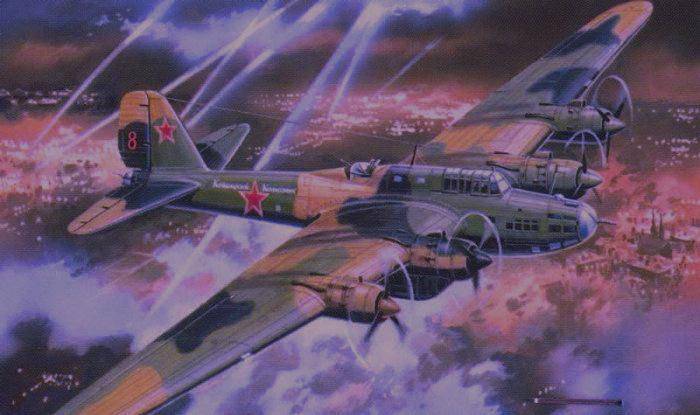
Already during the return to the Vodopyanova bomber, the engine fails, but Mikhail Vasilyevich successfully lands the plane in the forest. The plane was broken, but no one was injured from the crew. The pilots were able to cross the front line and return to the unit.
Soon, Mikhail Vasilyevich was summoned to Moscow to receive Stalin. The Supreme Commander was clearly dissatisfied with the fact that out of ten cars that participated in the raid on Berlin, only two returned. Vodopyanova was removed from the post of division commander. But he continued to fight the commander of the crew. Only in 1943 year M.V. Vodopyanov was awarded the rank of Major General of Aviation.
After the end of the war, Mikhail Vasilyevich continued service in polar aviation. In 1948, Vodopyanov took an active part in organizing the new research station North Pole-2. In 1949, he was presented for the title of twice Hero of the Soviet Union, however, he received only the second Order of Lenin. Now it is known that his landing was a landing at the South Pole, but earlier this event was top secret.
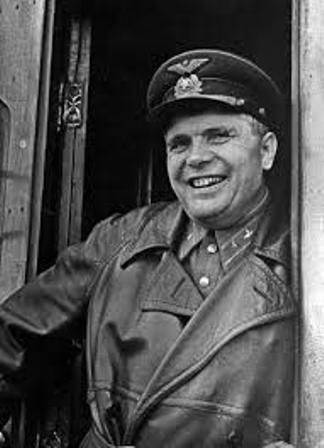
On the well-deserved rest, Mikhail Vasilyevich was actively engaged in literary work. He had written many books, and his two dramas were on stage theaters. M.V. died Vodopyanov 11 August 1980 of the year.
The memory of the great pilot is immortalized in the street names. His name was given to the first of a series of IL-96-300 aircraft of Domodedovo Airlines, SSJ100-95, as well as the strategic bomber Tu-160 and IL-76.
Sources:
Artamonov V.I. Earth and sky Vodopyanova. M .: Politizdat, 1991. C. 27-42.
Medved A., Sedlovsky A. To oblige Comrade Vodopyanov // Aviation and Time. 1996. No.1. C. 35-40.
Grishaeva G. Schedro lived, skillfully flew // Civil Aviation. 1994. No.11. C.14-15.
Demin A. The Forgotten Pages of the Chelyuskin Epic // Aviation and Cosmonautics. 1999. No.4. C.10-12.
Nikolsky M. 203-th Guards Orlovsky Aviation Regiment // Aviation and Cosmonautics. 2004. No.3. C. 1-3.
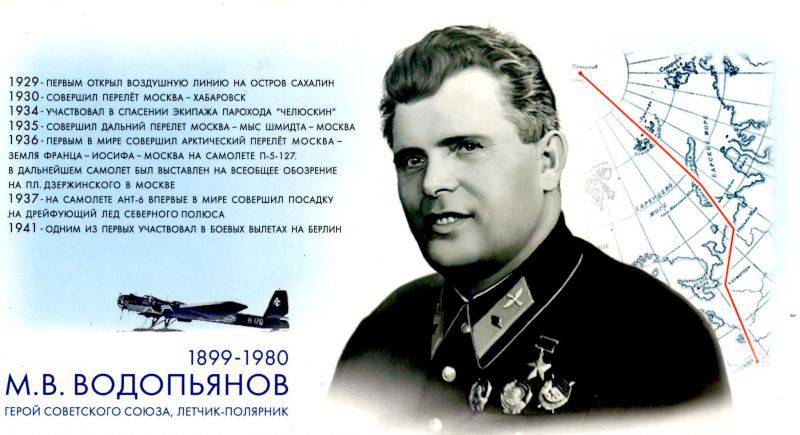
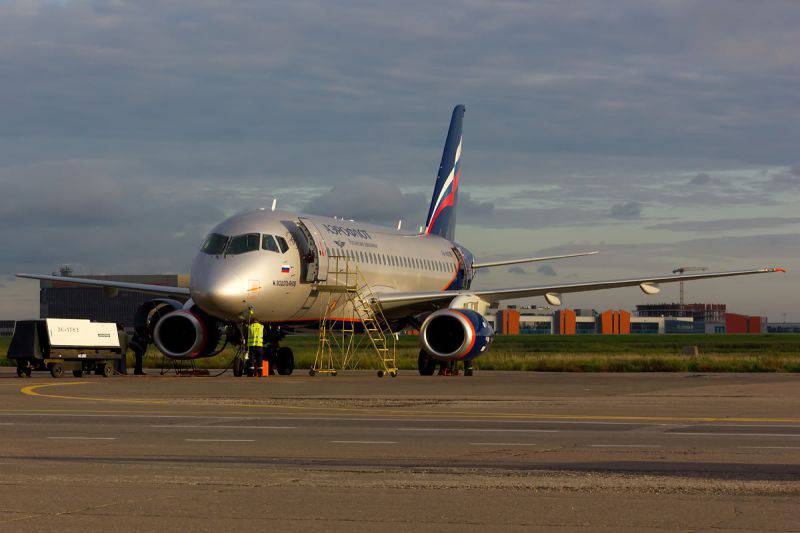
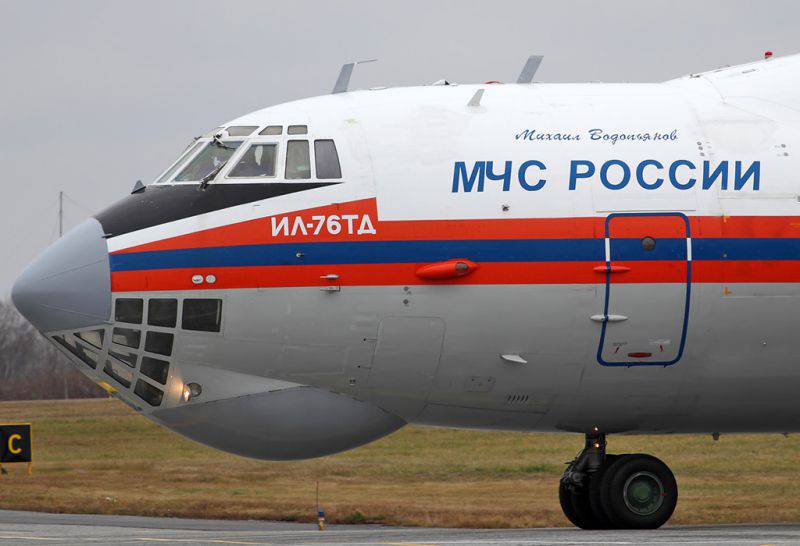
Information